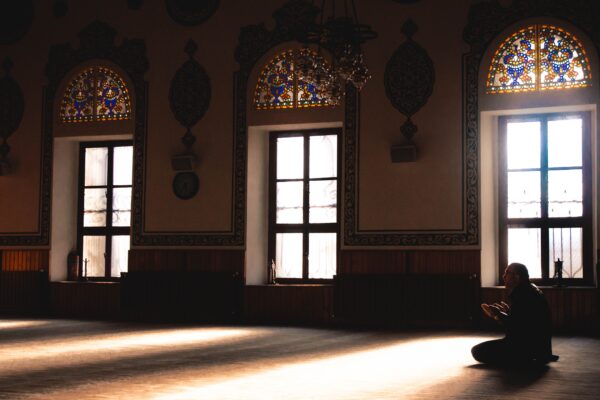The prayer of Raghaib performed on the eve of the first Juma on Rajab draws wide criticism. In this article, we summarise the varying viewpoints.
The prayer of Raghaib performed on the eve of the first Juma on Rajab draws wide criticism. In this article, we summarise the varying viewpoints.
Laylatul Raghaib is marked on the eve of the first Juma of Rajab by millions of Muslims, whilst other Muslims refrain, considering it a bidah or innovation.
This article will look at the reasons for the differing viewpoints without taking a side.
What Does Laylatul Raghaib Mean?
The Arabic word ‘raghaib’ comes from the root ra-gha-ba, which translates to wishing for something or something that is deeply desired. Layl, as we know, means night. Hence, Laylatul Raghaib: The Night of Wishes.
Derivatives of this word have been used in many places in the Quran, such as in “wishing” to marry someone.
What Happens on Laylatul Raghaib?
On the night of raghaib, Muslims are encouraged to perform many acts of worship, such as fasting on the day, reading the Quran, performing ghusl, reciting duas and giving to charity.
However, there is one act on this night that draws criticism, and it’s the prayer of raghaib. It is recommended to perform it between the maghrib and isha prayers, and it goes like this:
- A 12 rakat prayer, prayed in two rakats each i.e. it’s done like the fajr prayer but six times.
- In each rakat, after reciting Surah Fatiha, one recites Surah Qadr three times and Surah Iklhas 12 times.
Thereafter, there are various recommended dhikrs.
What is the Source of the Prayer of Raghaib?
The source is a hadith from the Prophet Muhammad, which goes like this:
It is most important, however, that none of you should neglect the first Thursday night in Rajab, for it is the night that the angels call the Night of Wishes. This is because, by the time the first third of the night has elapsed, there will not be a single angel still at large in the heavens, nor in any region of the earth bar one. They will all be gathered together in the Ka’ba and the area immediately surrounding it. Allah will condescend to notice that they have assembled there, and He will say: ‘My angels, ask Me for whatever you wish!’ Their response to this will be: ‘Our Lord, the request we wish to make is that You grant forgiveness to those who faithfully keep the fast in Rajab,’ whereupon Allah will tell them: ‘That I have already done!’”
Criticisms of the Prayer of Raghaib
The important thing to note is all sects of Muslims deem this hadith weak and inauthentic. Both Sunni schools and Shia schools admit the hadith is weak, yet some maintain it is still OK to pray it, whilst others say it’s an innovation.
Opinion 1: It’s an Innovation
The logic of those who follow this opinion is as follows: we are only to follow the Sunnah of Prophet Muhammad (PBUH). If he didn’t do something, we shouldn’t be doing it. This hadith is weak. Therefore it is highly likely he didn’t do it, so we should not do it.
For example, the Shafi’i scholar Al-Nawawi says:
The prayer which is known as salaat al-raghaa’ib, which is twelve rak’ahs that are offered between Maghrib and ‘Isha’ on the night of the first Friday in Rajab, and praying one hundred rak’ahs on the night of Nusf Sha’baan (halfway through Sha’baan) are both reprehensible innovations. No one should be deceived by the fact that they are mentioned in Qoot al-Quloob and Ihya’ ‘Uloom al-Deen, or by the hadeeth which is quoted in these two books, because all of that is false. No one should be deceived by some of those imams who were confused about the ruling on these prayers and wrote essays stating that they are mustahabb, for they are mistaken in that. Imam Abu Muhammad ‘Abd al-Rahmaan ibn Isma’eel al-Maqdisi wrote a valuable book showing that they are false, and he did well in that, may Allaah have mercy on him.
This opinion is recorded in the book Majmoo al-Fatawaa, written by Shaykh ibn Taymiyyah.
Ibn al-Haaj al-Maaliki, a Maliki scholar, has also stated that the prayer is makruh (discouraged).
Other scholarly opinions on this side of the fence follow a similar sentiment.
Opinion 2: We Can Perform the Prayer
The people who sit on the other side of the fence concede the original hadith from the Prophet is weak but still maintain one can pray it if the following conditions are met:
- It’s not prayed in a congregation (like the five compulsory prayers)
- It has the right intention:
- The intention should not be that the prayer is recommended
- The intention should be that the prayer may have some goodness in it, and if there is, may Allah bring it to its performer.
They don’t agree with the logic that if a hadith is weak, then acting on its contents becomes an innovation. They say acting on a fabricated hadith would be an innovation, but not on a weak one because there is still a chance (however weak) that the hadith could be true.
Furthermore, if we do assume that acting on it is an innovation, there is also the concept that an innovation can be a good thing (bidah hasanat). The second caliph, Umar ibn Khattab is an example of someone who allowed something that the Prophet never did, citing it as a good bidah (from Sahih Bukhari):
Abdur Rahman bin ‘Abdul Qari said:
I went out in the company of ‘Umar bin Al-Khattab one night in Ramadan to the mosque and found the people praying in different groups. A man praying alone or a man praying with a little group behind him. So, ‘Umar said, ‘In my opinion I would better collect these (people) under the leadership of one Qari (Reciter) (i.e. let them pray in congregation!)’. So, he made up his mind to congregate them behind Ubai bin Ka’b. Then on another night I went again in his company and the people were praying behind their reciter. On that, ‘Umar remarked, ‘What an excellent Bid’a (i.e. innovation in religion) this is.”
This is a summary of the two opinions, and Allah (SWT) knows best.





